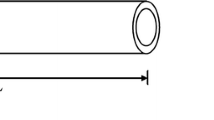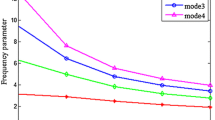Abstract
This study applies DE (discrete element) computational method to the dynamic problems of a vibrating string. The DE method was originally initiated to analyze granular materials and now it has expanded to model fabric dynamics which is of interest in a number of applications including those that manufacture or handle textiles, garments, and composite materials. Owing to the complex interactions between each discrete element, simple circular geometric rigid model has been used in the conventional DE method. However, in order to analyze the slender shape and flexibility of materials such as fabrics or strings, longer and flexible geometric models, named as fiber models, was developed. The fiber model treats a series of connected circular particles, and further can be classified as being either a RF (rigid fiber) or a CFF (completely flexible fiber) model. To check the feasibility of those models, dynamic problems were solved and it is found that the fiber models accurately simulate the dynamic and vibration behaviors of horizontally or vertically placed strings.
Similar content being viewed by others
References
P. A. Cundall and O. D. L. Strack, A discrete numerical model for granular assemblies, Geotechnique, 29(1) (1979) 47–65.
C. S. Campbell and C. E. Brennen, Computer simulation of granular shear flows, Journal of Fluid Mechanics, 151 (1985) 167–188.
A. Acharya, A distinct element approach to ball mill mechanics, Communications in Numerical Methods in Engineering, 16 (2000) 743–753.
P. Cleary, Modelling comminution devices using DEM, Int. J. Numer. Anal. Meth. Geomech., 25(1) (2001) 83–105.
C. M. Van Wyk, Note on the compressibility of wool, Journal of the Textile Institute, 36 (1946) T285–T292.
O. R. Walton and R. L. Braun, Viscosity, granular-temperature, and stress calculations for shearing assemblies of inelastic frictional disks, Journal of Rheology, 30(5) (1986) 949–980.
C. R. Wassgren, Vibration of granular materials, Ph.D Thesis, California Institute of Technology, Pasadena, CA, (1997).
C. S. Campbell, Computer simulation of rapid granular flows, Proc. 10th US National Congress of Appl. Mech., (1986) 327–338.
R. D. Mindlin and H. Deresiewicz, Elastic spheres in contact under varying oblique forces, Journal of Applied Mechanics, 20 (1953) 327–344.
N. Maw, J. R. Barber and J. N. Fawcett, The oblique impact of elastic spheres, Wear, 38(1) (1976) 101–114.
W. W. Carr, J. E. Posey and W. C. Tincher, Frictional characteristics of apparel fabrics, Textile Research Journal, 58(3) (1988) 129–136.
D. E. Breen, D. H. House and M. J. Wozny, A particle-based model for simulating the draping behavior of woven cloth, Textile Research Journal, 64(11) (1994) 663–685.
D. N. Fernando, Size segregation in granular beds subject to continuous and discrete oscillations, M.S. Thesis, Purdue University, West Lafayette, IN, (2001).
J. L. Meriam and L. G. Kraige, Engineering Mechanics-Dynamics, John Wiley & Sons, (2002).
D. Yong, String, chains and ropes, SIAM Review, 48(4) (2006) 771–781.
Author information
Authors and Affiliations
Corresponding author
Additional information
This paper was recommended for publication in revised form by Associate Editor Hong Hee Yoo
Junyoung Park received B.S. and M.S degrees in Mechanical Engineering from Kyungpook National University in 1996 and 1998, respectively. He then went on to receive his Ph.D. degree from Purdue University in 2003. Dr. Park is currently an assistant professor at the School of Mechanical Engineering at Kumoh National Institute of Technology in Gumi, Korea. Dr. Park’s research interests are in the area of nano technology, particle technology, and analysis of pedestrian flow.
Namcheol Kang received B.S. and M.S degrees in Mechanical Engineering from KAIST and Seoul National University in 1992 and 1994, respectively. He then went on to receive his Ph.D. degree from Purdue University in 2004. Dr. Kang is currently an assistant professor at the School of Mechanical Engineering at Kyungpook National University in Daegu, Korea. Dr. Kang’s research interests are in the area of dynamics, vibration and stability of a multiscale mechanical system.
Rights and permissions
About this article
Cite this article
Park, J., Kang, N. Applications of fiber models based on discrete element method to string vibration. J Mech Sci Technol 23, 372–380 (2009). https://doi.org/10.1007/s12206-008-0921-8
Received:
Revised:
Accepted:
Published:
Issue Date:
DOI: https://doi.org/10.1007/s12206-008-0921-8




